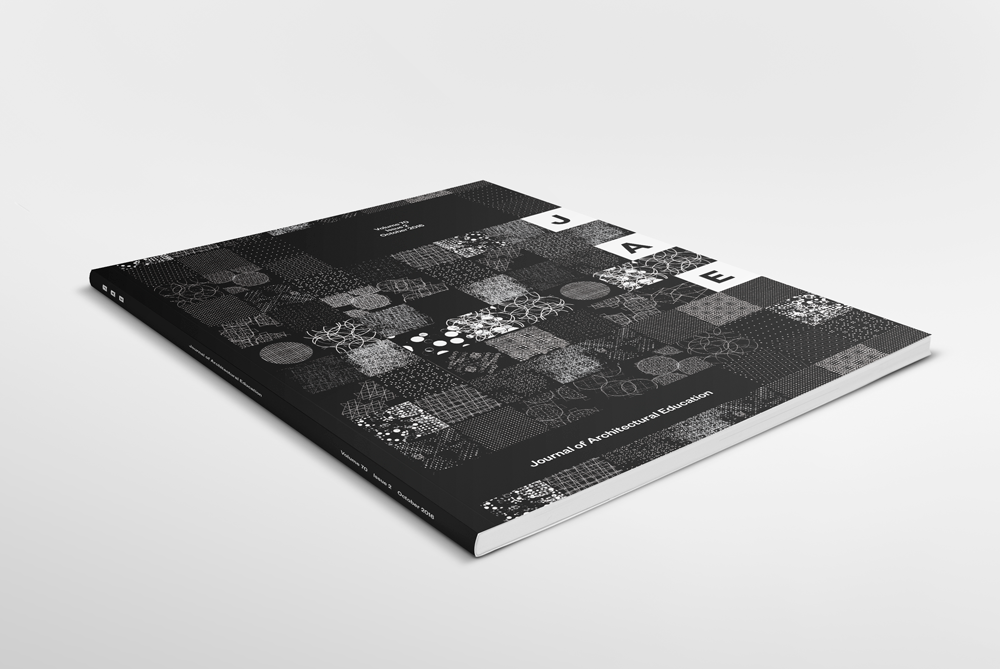
This issue is the second in a volume year that has been named “open.” In reality, the issues 70:1 and 70:2 are comprised of essays—Scholarship of Design and Design as Scholarship—that were submitted to a non-themed call for papers in August 2015. We received over 130 essays for the call and, as a result of the number submitted, decided to spread the content over the entire volume year. This allowed for more scholarship to be published and the opportunity for an issue devoted to design. The first issue in this volume year presented Design as Scholarship with a focus on the artifacts that architects construe and construct. That issue, edited by Amy Kulper, also introduced a new design framework: the Discursive Image. The issue you now hold in your hands is exclusively Scholarship of Design. The volume year was named as “open” in response to a renewed call to publish across a range of topics. The JAE is not able to publish more content, but we can publish more diverse content. The evolution of the Design as Scholarship, the opening up of reviews to other types of architectural production, and the diversity of recent and future themes reflects our awareness that scholarship in architecture is varied.
Regardless of the content, all essays are bound to double-blind peer review by at least two reviewers, including members of our Editorial Board. Double-blind peer review, in which the authors’ and reviewers’ identities are not known, is intended to prevent bias, be it personal, academic, or professional. Further, it limits any possibility of retaliation against the reviewer. The hope is, of course, that good scholarship trumps academic politics. The process is not foolproof. A quick Internet search may offer clues to the name of the author. The process, however, is still considered essential for tenure and promotion. Beyond the function in professional advancement, reviewers’ comments play an essential role in developing scholarship. All authors, rejected or accepted, are sent (sometimes voluminous) reviewer comments. The feedback is intended to help authors develop their work, and it is not unusual for an essay to be resubmitted to a future call after it has been rejected and the author has developed the paper in response to reviewers’ comments. The essays with the highest reviews are forwarded for publication and, once selected, are read and additional comments are provided by the editors. Given the variety of content, the difficulty is not necessarily in curating an issue such as this (as a theme was never intended), but rather in offering edits across a spectrum of topics.
Architectural research and scholarship has certainly changed since the first issue of the JAE in 1947, the topic of which was in fact “research in architecture.” Over its entire tenure the JAE has continued to be a peer-reviewed journal. The exponential growth of opportunities for publication over the past seventy years, the potential of digital scholarship to transform the way in which research is undertaken and presented, and the unprecedented organization and collection, and resultant ability to sort and search through massive amounts of scholarship, present authors, readers, reviewers, and students with an overwhelming amount of information. It is often difficult to discern value in the surfeit of scholarship. The usefulness of research in the sciences is in the timeliness of the results. New research advances techniques in ways that allow for more efficient, productive, and, essentially, better responses to issues of health, the environment, natural resources, and most any other “problem” to be solved. I would not make the claim that any of the essays in this issue present cutting-edge research. New ideas are discussed, certainly. Old characters are presented in new ways. I would argue the value in the essays, and hopefully in all the work published in the JAE, is not the timeliness of the research but the timelessness of the scholarship.
During the production of this issue, Norman Millar, former President of the ACSA and Dean of the School of Architecture at Woodbury University, passed away. Over the summer his personal belongings in his office were returned to his family. On his bookshelf was a collection of the Journal of Architectural Education, dating back to when he first began teaching. Not only did he support the work of the JAE Editorial Board in his role as ACSA President, he was clearly a reader of the journal. A passionate educator, administrator, and architect, Norman will be missed.
In Memoriam,
Norman Millar
Continue Reading:






